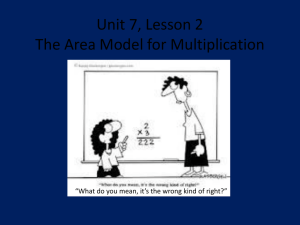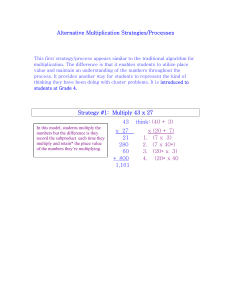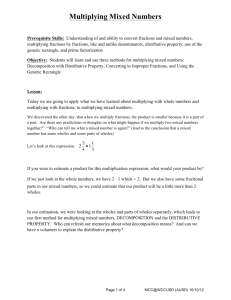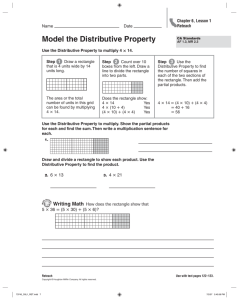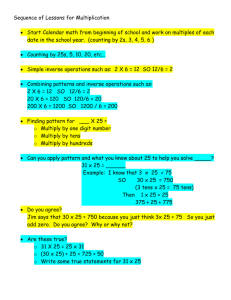Multiplying with Multi-‐digit Numbers Warm Up We have looked at
advertisement
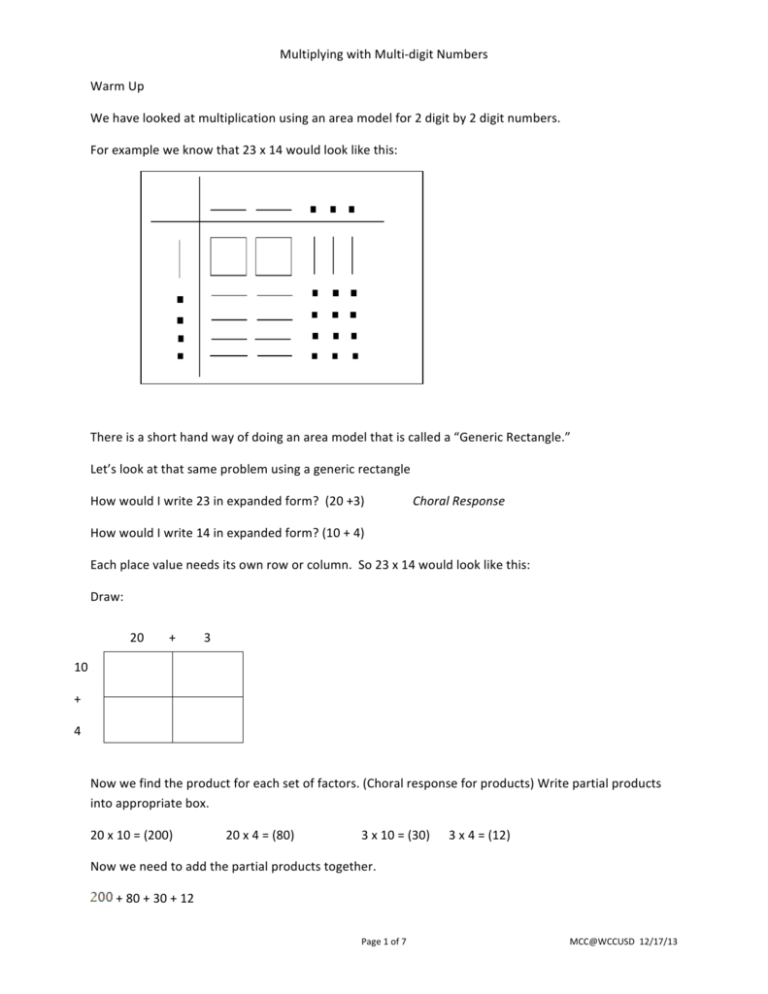
Multiplying with Multi-­‐digit Numbers Warm Up We have looked at multiplication using an area model for 2 digit by 2 digit numbers. For example we know that 23 x 14 would look like this: There is a short hand way of doing an area model that is called a “Generic Rectangle.” Let’s look at that same problem using a generic rectangle How would I write 23 in expanded form? (20 +3) Choral Response How would I write 14 in expanded form? (10 + 4) Each place value needs its own row or column. So 23 x 14 would look like this: Draw: 20 + 3 10 + 4 Now we find the product for each set of factors. (Choral response for products) Write partial products into appropriate box. 20 x 10 = (200) 20 x 4 = (80) 3 x 10 = (30) 3 x 4 = (12) Now we need to add the partial products together. + 80 + 30 + 12 Page 1 of 7 MCC@WCCUSD 12/17/13 I am going to use decomposition to help me add these numbers: Think aloud: I know that 80 + 20 = 100 so I am going to break apart the 30 to 20 + 10, and I am going to break apart the 12 by place value to see if that helps me combine the numbers in a friendly way. 200 + 80 + 20 + 10 + 10 + 2 = 200 + 100 + 20 + 2 = 322 Is this the only way I could have decomposed these addends? (Consider having students share other ways to decompose) So the product of 23 x 14 = 322 Why might I choose to use a generic rectangle instead of an area model? (Possible answers -­‐ more efficient, takes up less room) Guided You try: 17 x 35 Ask same questions as on the example problem. Students do the thinking – teacher records. 10 + 7 30 210 300 + 5 50 35 300 + 210 + 50 + 35 = 300 + 200 + 10 + 50 + 30 + 5 = 500 + 90 + 5 = 595 “Would it matter if I put 30 + 5 across the top of my rectangle and 10 + 7 down the side? (No) Why wouldn’t it matter? (The commutative property of multiplication allows me to multiply the factors in any order) (Can model switching the factors and seeing that you arrive at the same products.) What do you think I would do if I was finding the product of a 3 digit and a 2 digit number and I wanted to use the generic rectangle? (I would need to add another row or column to my rectangle) Page 2 of 7 MCC@WCCUSD 12/17/13 Let’s do a problem from your warm up in a generic in pairs. 215 x 57 How do I write 215 in expanded form? (200 + 10 + 5) How many rows or columns will I need for this factor? (3) Why? (Because there are 3 place values.) How do I write 57 in expanded form? (50 + 7) How many rows or columns for this factor? Why? (Because there are 2 place values.) So my generic rectangle will by 3 by 2. Draw it and write in the expanded form of the products. 200 + 10 + 5 5 50 + 7 What do we do next? (Find the partial products) Work with your partner and find the partial products. (lower affective filter) Have students share out the partial products and complete the generic rectangle. 50 x 200 = 10,000 50 x 10 = 500 50 x 5 = 250 7 x 200 = 1,400 7 x 10 = 70 7 x 5 = 35 What do we do next? (add the partial products together) 10,000 + 500 + 250 + 1,400 + 70 + 35 =10,000 + 1,400 + 500 + 250 + 70 + 35 =10,000 + 1,900 + 300 + 20 + 35 =10,000 + 2,200 + 55 =12,255 During debrief ask “Does it matter which box we start in? (No) Could we start somewhere else? (Yes) Would the product be the same? (Yes) Do “You Try” again going in a different order. Page 3 of 7 MCC@WCCUSD 12/17/13 You Try: 318 x 24 (Independently) 300 + 10 + 8 20 + 4 6,000 1,200 200 40 160 32 0r 20 + 4 1,200 6,000 300 + 40 300 10 + 8 160 32 6,000 + 1,200 +200 + 160 + 40 + 32 =7,400 + 200 + 32 =7,632 Now we are going to look at these same problems with another way to solve them called Partial Products Our first problem was 23 x 14. We solved that with an area model and the generic rectangle. Now we will solve using partial products: Have you heard of partial sums? (Connect to prior knowledge) Turn to your partner and tell them what partial sums are. Who can share with the class the definition of partial sums? Page 4 of 7 MCC@WCCUSD 12/17/13 Partial products are similar to partial sums except that you will be multiplying instead of adding. 23 OR 23 x 14 x 14 12 (4 x 3) 30 (10 x 3) 80 (4 x 20) 200 (10 x 20) 30 (10 x 3) 80 (4 x 20) + 200 (10 x 20) + 12 (4 x 3) 322 322 Just like the generic rectangle, when doing partial products, you can multiply the digits in any order – but, you must pay careful attention to the place value of each digit. Do: Work the example out as you are explaining If I start with the 4 in 14, I first multiply 4 times the 3 in 23. What is the place value of the 4? (Ones) What is the place value of the 3? (ones.) What is 4 x 3? (12) I will write this partial product down. Now I am going to multiply the 4 and the 2. What is the place value of the 2? (tens.) What is the value? (20) Yes, 20. So I multiply 4 ones by 2 tens or 20. What is 4 x 20? (80) Yes, 80. I write the 80 below the 12. Now I am going to multiply the 1 in 14. What is the place value of the one? (tens) Yes so what is the value? (10) Yes 10. 10 x 3 = 30. Have I multiplied all the digits? (no.) What else do I need to multiply? (The one times the 2 or 10 times 20) I need to multiply the one in the tens place by the 2 in the tens place, so what is 10 x 20? (200) Now I have the 4 partial products and to find the final product I need to add the partial products together. When doing partial products, I can start with any digit. Show other example using the same questioning. You try in Pairs: 17 x 35 17 x 35 300 (30 x 10) 210 (30 x 7) 50 (5 x 10) + 35 (7 x 5) 595 Page 5 of 7 MCC@WCCUSD 12/17/13 So do you think partial products will work when we are multiplying with a 3-­‐digit number? Let’s do one together 215 x 57 Does it matter if I start in the ones place or the tens place? (no) 215 x 57 10,000 (50 x 200) 500 (50 x 10) 250 (50 x 5) 1,400 (7 x 200) 70 (7 x 10) + 35 (7 x 5) 12,255 I am going to multiply the 5 x 2 but is it really 5 x 2? (No, it is 50 x 200) The 2 is in the hundreds place and the 5 is in the 10’s place so it is 50 x 200. Continue talking through each step pointing out the place value and the value. You Try Independently: 318 x 24 318 x 24 32 (4 x 8) 40 (4 x 10) 1200 (4 x 300) 160 (20 x 8) 200 (20 x 10) +6000 (20 x 300) 7,632 Page 6 of 7 MCC@WCCUSD 12/17/13 You try 3ways: 217 x 43 Partial Products 217 Generic Rectangle x 43 21 (3 x 7) 200 30 (3 x 10) + 600 (3 x 200) 280 (40 x 7) 10 400 (40 x 10) + + 8000 (40 x 200) 7 40 + 3 600 8,000 2 2 2 1 7 x 4 3 1 6 5 1 1 30 400 + 8 6 8 0 9, 3 3 1 280 21 9,331 8,000 + 600 + 400 + 30 + 28 + 21 = 9,331 Traditional Page 7 of 7 MCC@WCCUSD 12/17/13
